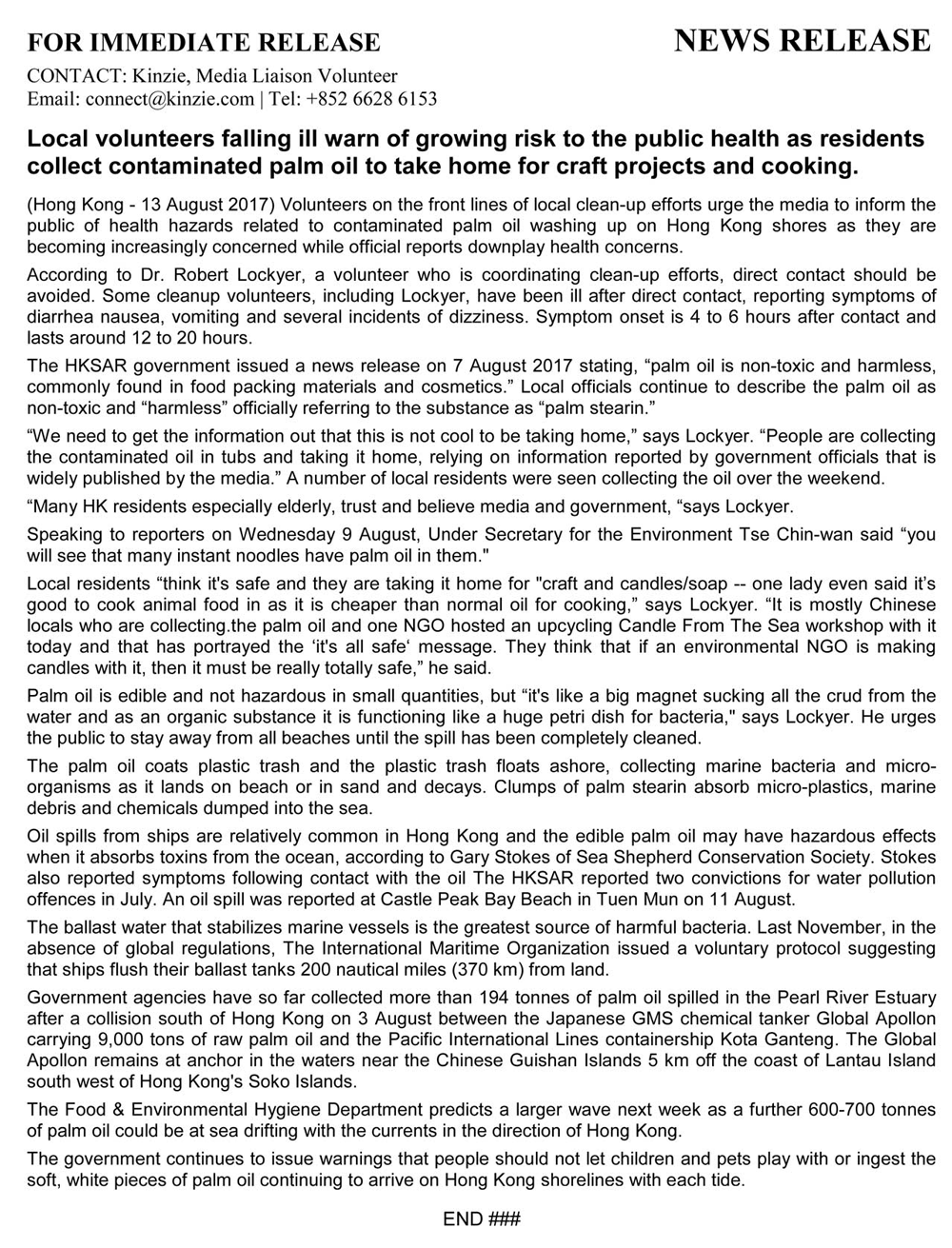Private citizen’s volunteer campaign to raise awareness and action, 2017
FOR IMMEDIATE RELEASE
CONTACT: Kinzie, Media Liaison Volunteer
Email: connect@kinzie.com | Tel: +852 6628 6153
Local volunteers warn of growing risk to the public health as Hong Kong residents collect contaminated palm oil to take home for upcycling craft projects and cooking.
(Hong Kong – 13 August 2017) Volunteers on the front lines of local clean-up efforts urge the media to inform the public of health hazards related to contaminated palm oil washing up on Hong Kong shores as they are becoming increasingly concerned while official reports downplay health concerns.
According to Dr. Robert Lockyer, a volunteer who is coordinating clean-up efforts, direct contact should be avoided. Some cleanup volunteers, including Lockyer, have been ill after direct contact, reporting symptoms of diarrhea nausea, vomiting and several incidents of dizziness. Symptom onset is 4 to 6 hours after contact and lasts around 12 to 20 hours.
The HKSAR government issued a news release on 7 August 2017 stating, “palm oil is non-toxic and harmless, commonly found in food packing materials and cosmetics.” Local officials continue to describe the palm oil as non-toxic and “harmless” officially referring to the substance as “palm stearin.”
“We need to get the information out that this is not cool to be taking home,” says Lockyer. “People are collecting the contaminated oil in tubs and taking it home, relying on information reported by government officials that is widely published by the media.” A number of local residents were seen collecting the oil over the weekend.
“Many HK residents especially elderly, trust and believe media and government, “says Lockyer.
Speaking to reporters on Wednesday 9 August, Under Secretary for the Environment Tse Chin-wan said “you will see that many instant noodles have palm oil in them.”
Local residents “think it’s safe and they are taking it home for “craft and candles/soap — one lady even said it’s good to cook animal food in as it is cheaper than normal oil for cooking,” says Lockyer. “It is mostly Chinese locals who are collecting.the palm oil and one NGO hosted an upcycling Candle From The Sea workshop with it today and that has portrayed the ‘it’s all safe‘ message. They think that if an environmental NGO is making candles with it, then it must be really totally safe,” he said.
Palm oil is edible and not hazardous in small quantities, but “it’s like a big magnet sucking all the crud from the water and as an organic substance it is functioning like a huge petri dish for bacteria,” says Lockyer. He urges the public to stay away from all beaches until the spill has been completely cleaned.
The palm oil coats plastic trash and the plastic trash floats ashore, collecting marine bacteria and micro-organisms as it lands on beach or in sand and decays. Clumps of palm stearin absorb micro-plastics, marine debris and chemicals dumped into the sea.
Oil spills from ships are relatively common in Hong Kong and the edible palm oil may have hazardous effects when it absorbs toxins from the ocean, according to Gary Stokes of Sea Shepherd Conservation Society. Stokes also reported symptoms following contact with the oil The HKSAR reported two convictions for water pollution offences in July. An oil spill was reported at Castle Peak Bay Beach in Tuen Mun on 11 August.
The ballast water that stabilizes marine vessels is the greatest source of harmful bacteria. Last November, in the absence of global regulations, The International Maritime Organization issued a voluntary protocol suggesting that ships flush their ballast tanks 200 nautical miles (370 km) from land.
Government agencies have so far collected more than 194 tonnes of palm oil spilled in the Pearl River Estuary after a collision south of Hong Kong on 3 August between the Japanese GMS chemical tanker Global Apollon carrying 9,000 tons of raw palm oil and the Pacific International Lines containership Kota Ganteng. The Global Apollon remains at anchor in the waters near the Chinese Guishan Islands south west of Hong Kong’s Soko Islands.
The Food & Environmental Hygiene Department predicts a larger wave next week as a further 600-700 tonnes of palm oil could be at sea drifting with the currents in the direction of Hong Kong.
The government continues to issue warnings that people should not let children and pets play with or ingest the soft, white pieces of palm oil continuing to arrive on Hong Kong shorelines with each tide.
END ###
Read more: about the palm oil spill

